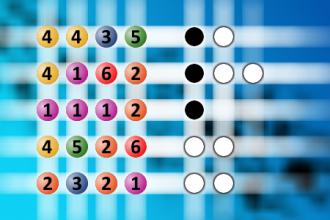Which is a winning combination of digits?
The computer chose a secret code (sequence of 4 digits from 1 to 6). Your goal is to find that code. Black circles indicate the number of hits on the right spot. White circles indicate the number of hits on the wrong spot.Correct answers: 35
The first user who solved this task is Thinh Ddh.
#brainteasers #mastermind

There’s a light inside of everyone
There’s a light inside of everyone. No matter what, someone is always going to come around and try to dim that light or shut it off. Whatever you do, you hold on to that light and you fight. You fight to not let that person tear you down, you fight for the right to define yourself, to not let anyone else tell you who you are. You gotta keep your head up, because people will always hang around waiting for you to fall, for the light to shut off. Don’t ever let someone fade the light that makes you beautiful. Because in the end, you’re the one who controls how brightly you shine.

